February 2013 Retail Sales increased, by 1.1%. Gasoline sales shot up 5.0% from January on higher prices. If one removes gasoline sales from retail sales, overall the increase from January would have been 0.6%. Auto sales increased 1.1% and minus all autos & parts but including gas sales, retail sales increased 1.0% from last month. This report should alleviate Wall Street's worries people are so tapped out they have stopped spending. It didn't happen, yet. Retail sales are reported by dollars, not by volume with price changes removed.
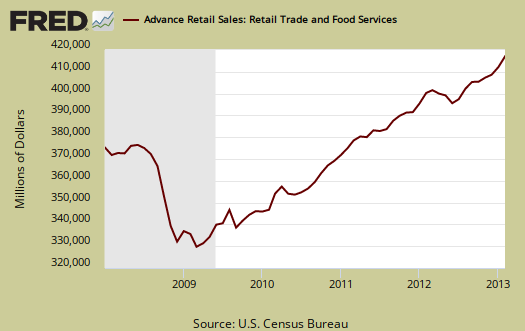
For the three month moving average, from December to February in comparison to September to November, retail sales have increased 1.3%. The retail sales three month moving average in comparison to a year ago is up 4.5%.
Retail trade sales are retail sales minus food and beverage services. Retail trade sales includes gas, and is up 1.3% for the month, up 4.7% from last year.
Total retail sales are $421.4 billion for February. Below are the retail sales categories monthly percentage changes. These numbers are seasonally adjusted. General Merchandise includes super centers, Costco and so on. Online shopping making increasing gains, increasingly important in overall retail sales. Nonstore retail sales have increased 15.7% from last year. Autos sales have increased 8.8% from a year ago.
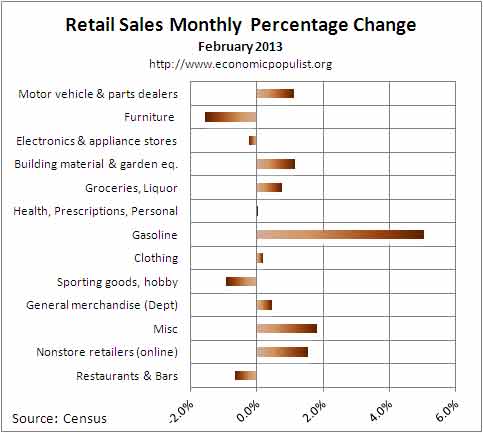
Gasoline station sales have increased 3.6% from one year ago. Sporting goods, hobbies, books & music sales have increased 3.9% from last year. Autos & parts sales overall have increased 7.8% from last year. The ones that are hurting are Departments stores. Their retail sales are down -3.8% from February 2012 with general merchandise stores overall are down -1.6% from a year ago. Building materials, garden sales, which are large by volume, have increased 4.5% from a year ago. Grocery stores have increased sales by 3.2% from this time last year. Below are the February retail sales categories by dollar amounts. As we can see, cars are king when it comes to retail sales. We also see that electronics is much smaller by total dollars.
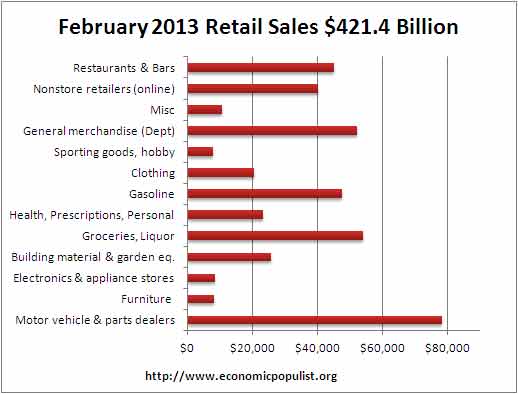
For reference sake, graphed below are weekly regular gasoline prices, so one can see what happened to gas prices in February.

The below pie chart breaks down the monthly seasonally adjusted retail sales by category as a percentage of total February sales by dollar amounts. One can see how dependent monthly retail sales are on auto sales by this pie chart. We also see non-traditional retailers making strong grounds on traditional general merchandise stores.
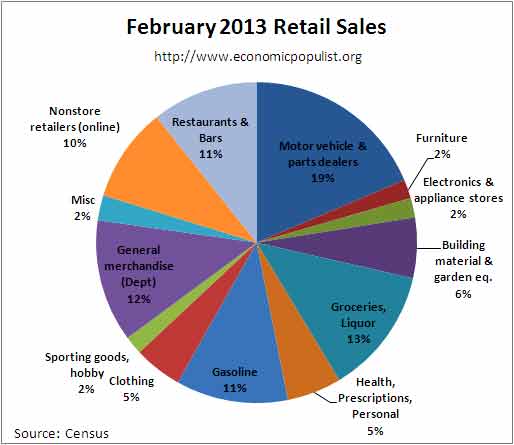
Retail sales correlates to personal consumption, which in turn is about 70% of GDP growth. Yet GDP has inflation removed from it's numbers. This is why Wall Street jumps on these retail sales figures. Below is the graph of retail sales in real dollars, or adjusted for inflation, so one gets a sense of volume versus price increases. Below is the annualized monthly percentage change in real retail sales, monthly.

To obtain real values, retail sales are deflated using CPI. Below are the real retail sales quarterly annualized percent change. The graph displays up to Q4 2012.

Below is a graph of real PCE against real retail sales, quarterly. See how closely the two track each other? PCE almost looks like a low pass filter, an averaging, removal of "spikes", of real retail sales. Here are our overviews for PCE. Here is our overview of Q4 GDP.
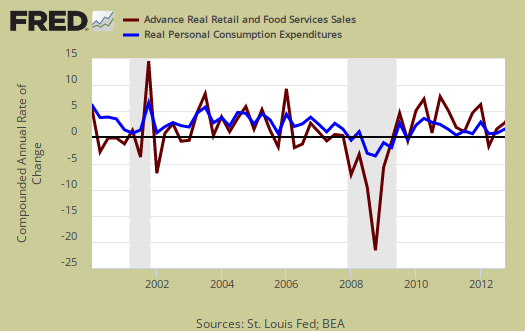
Retail sales are not adjusted for price increases, not reported in real dollars. Real economic growth adjusts for inflation. Retail sales has variance, margins of error, and is often revised as more raw data comes into the U.S. Department of Commerce (Census division). For example, this report has an error margin of ±0.5%. Data is reported via surveys, and is net revenues of retail stores, outlets. Online retail net revenues are asked in a separate survey of large retail companies (big box marts). This is also the advanced report. To keep the monthly nominal percentage changes in perspective, below is the graph of monthly percentage changes of retail sales since 2008.
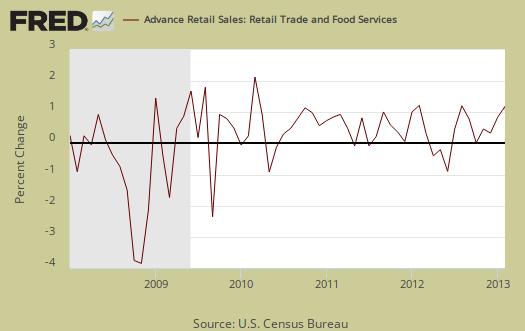
Seasonal adjustments are aggregate and based on events like holidays associated with shopping, i.e. the Christmas rush. Advance reports almost always are revised the next month as more raw sales data is collected by the Census. In other words, do not get married to these figures, they will surely be revised. Here is our retail sales topic category.

awesome charts
As always I love your charts and explanations.
Eye candy r us
Why Thank you. Takes longer, we'll never be "first", yet by taking the time and graphing out the statistics, so often we discover that the headline buzz has nothing to do with statistical reality.
This report is a Wall Street favorite. They don't seem to give a rats ass about hiring America, just make sure they keep spending. So warped.